climate control RENAULT TWINGO RS 2009 2.G Air Conditioning Owner's Manual
[x] Cancel search | Manufacturer: RENAULT, Model Year: 2009, Model line: TWINGO RS, Model: RENAULT TWINGO RS 2009 2.GPages: 122
Page 77 of 122
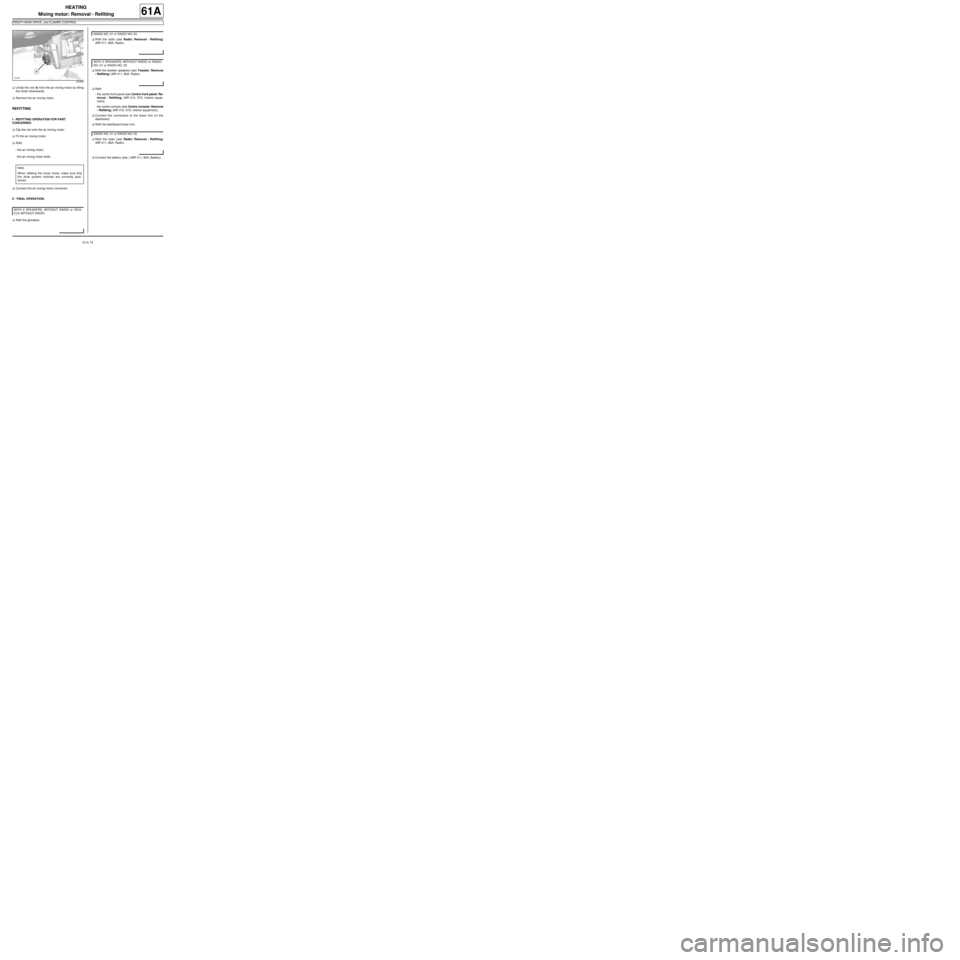
61A-74
HEATING
Mixing motor: Removal - Refitting
RIGHT-HAND DRIVE, and CLIMATE CONTROL
61A
aUnclip the rod (4) from the air mixing motor by tilting
the motor downwards.
aRemove the air mixing motor.
REFITTING
I - REFITTING OPERATION FOR PART
CONCERNED
aClip the rod onto the air mixing motor.
aFit the air mixing motor.
aRefit:
-the air mixing motor,
-the air mixing motor bolts.
aConnect the air mixing motor connector.
II - FINAL OPERATION.
aRefit the glovebox.aRefit the radio (see Radio: Removal - Refitting)
(MR 411, 86A, Radio).
aRefit the tweeter speakers (see Tweeter: Removal
- Refitting) (MR 411, 86A, Radio).
aRefit:
-the centre front panel (see Centre front panel: Re-
moval - Refitting) (MR 412, 57A, Interior equip-
ment).
-the centre console (see Centre console: Removal
- Refitting) (MR 412, 57A, Interior equipment),
aConnect the connectors to the lower trim on the
dashboard.
aRefit the dashboard lower trim.
aRefit the radio (see Radio: Removal - Refitting)
(MR 411, 86A, Radio).
aConnect the battery (see ) (MR 411, 80A, Battery).
124369
Note:
When refitting the mixer motor, make sure that
the drive system notches are correctly posi-
tioned.
WITH 2 SPEAKERS, WITHOUT RADIO or VEHI-
CLE WITHOUT RADIO
RADIO NO. 01 or RADIO NO. 03
WITH 2 SPEAKERS, WITHOUT RADIO or RADIO
NO. 01 or RADIO NO. 03
RADIO NO. 01 or RADIO NO. 03
Page 78 of 122
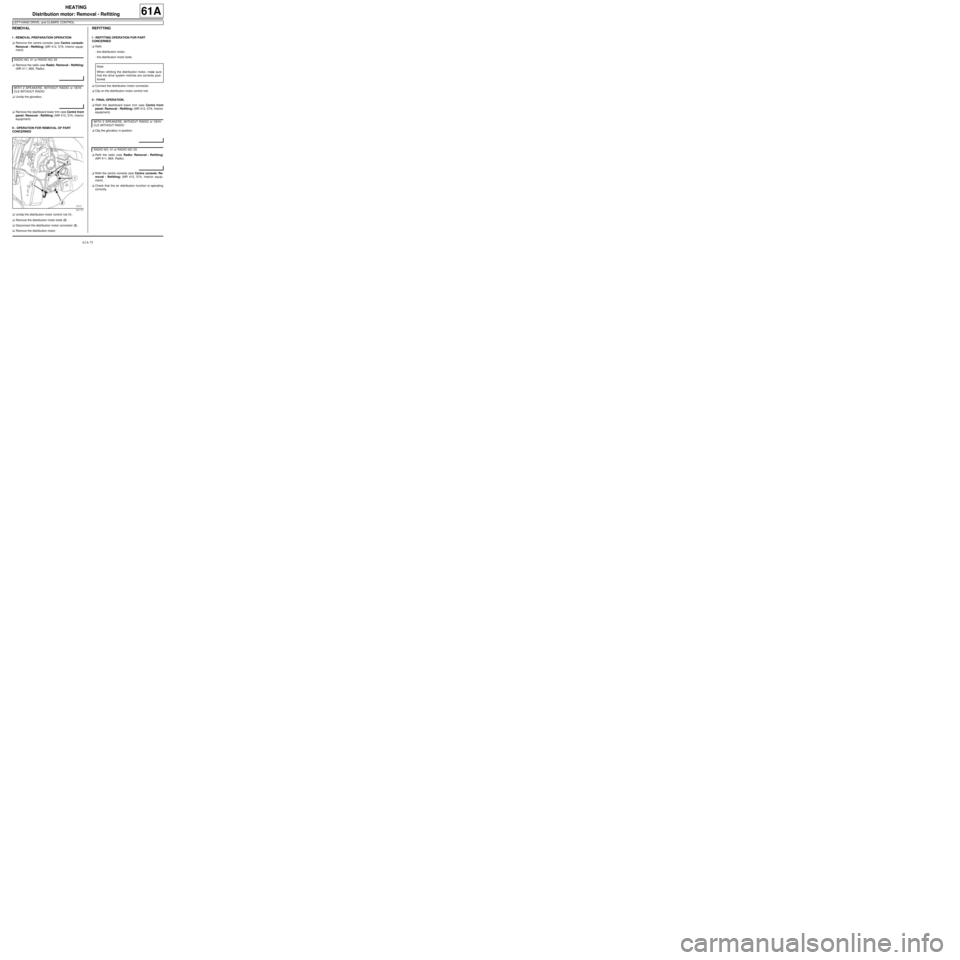
61A-75
HEATING
Distribution motor: Removal - Refitting
LEFT-HAND DRIVE, and CLIMATE CONTROL
61A
REMOVAL
I - REMOVAL PREPARATION OPERATION
aRemove the centre console (see Centre console:
Removal - Refitting) (MR 412, 57A, Interior equip-
ment).
aRemove the radio (see Radio: Removal - Refitting)
(MR 411, 86A, Radio).
aUnclip the glovebox.
aRemove the dashboard lower trim (see Centre front
panel: Removal - Refitting) (MR 412, 57A, Interior
equipment).
II - OPERATION FOR REMOVAL OF PART
CONCERNED
aUnclip the distribution motor control rod (1) .
aRemove the distribution motor bolts (2) .
aDisconnect the distribution motor connector (3) .
aRemove the distribution motor.
REFITTING
I - REFITTING OPERATION FOR PART
CONCERNED
aRefit:
-the distribution motor,
-the distribution motor bolts.
aConnect the distribution motor connector.
aClip on the distribution motor control rod.
II - FINAL OPERATION.
aRefit the dashboard lower trim (see Centre front
panel: Removal - Refitting) (MR 412, 57A, Interior
equipment).
aClip the glovebox in position.
aRefit the radio (see Radio: Removal - Refitting)
(MR 411, 86A, Radio).
aRefit the centre console (see Centre console: Re-
moval - Refitting) (MR 412, 57A, Interior equip-
ment).
aCheck that the air distribution function is operating
correctly. RADIO NO. 01 or RADIO NO. 03
WITH 2 SPEAKERS, WITHOUT RADIO or VEHI-
CLE WITHOUT RADIO
121177
Note:
When refi tting the distribution motor, make sure
that the drive system notches are correctly posi-
tioned.
WITH 2 SPEAKERS, WITHOUT RADIO or VEHI-
CLE WITHOUT RADIO
RADIO NO. 01 or RADIO NO. 03
Page 79 of 122
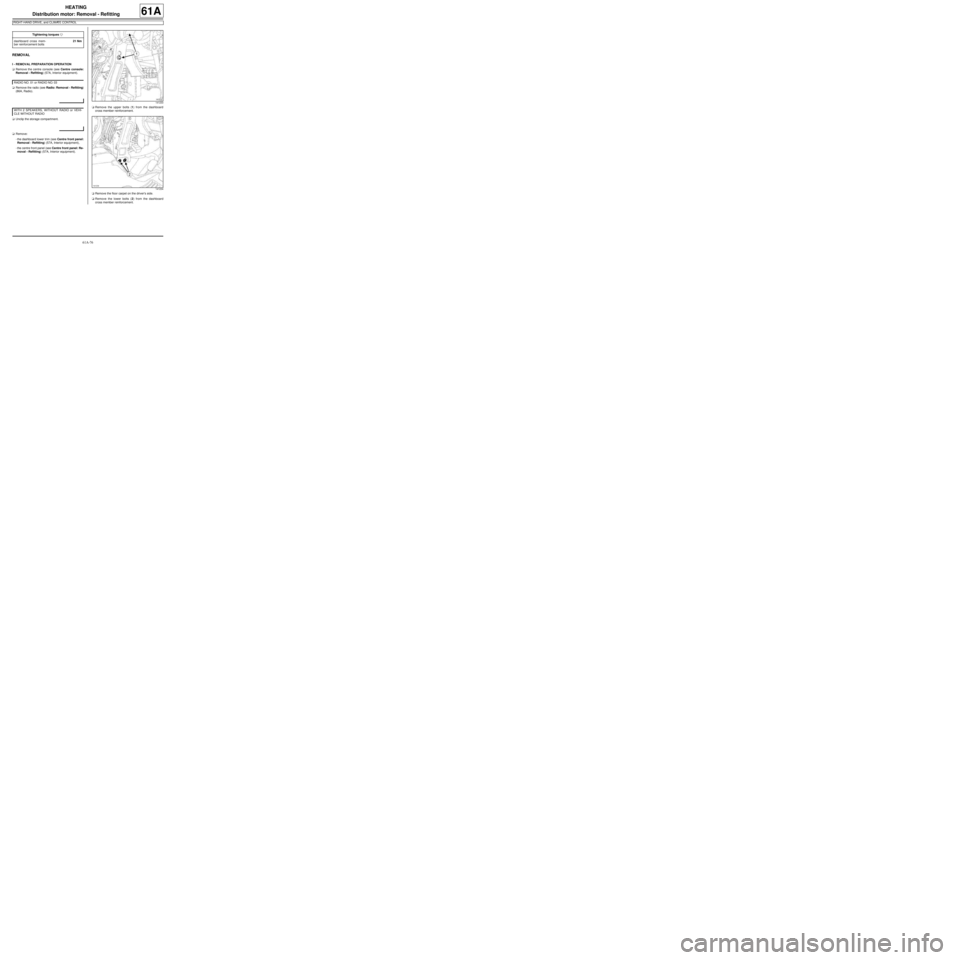
61A-76
HEATING
Distribution motor: Removal - Refitting
RIGHT-HAND DRIVE, and CLIMATE CONTROL
61A
REMOVAL
I - REMOVAL PREPARATION OPERATION
aRemove the centre console (see Centre console:
Removal - Refitting) (57A, Interior equipment).
aRemove the radio (see Radio: Removal - Refitting)
(86A, Radio).
aUnclip the storage compartment.
aRemove:
-the dashboard lower trim (see Centre front panel:
Removal - Refitting) (57A, Interior equipment),
-the centre front panel (see Centre front panel: Re-
moval - Refitting) (57A, Interior equipment).aRemove the upper bolts (1) from the dashboard
cross member reinforcement.
aRemove the floor carpet on the driver's side.
aRemove the lower bolts (2) from the dashboard
cross member reinforcement. Tightening torquesm
dashboard cross mem-
ber reinforcement bolts21 Nm
RADIO NO. 01 or RADIO NO. 03
WITH 2 SPEAKERS, WITHOUT RADIO or VEHI-
CLE WITHOUT RADIO
141233
141234
Page 80 of 122
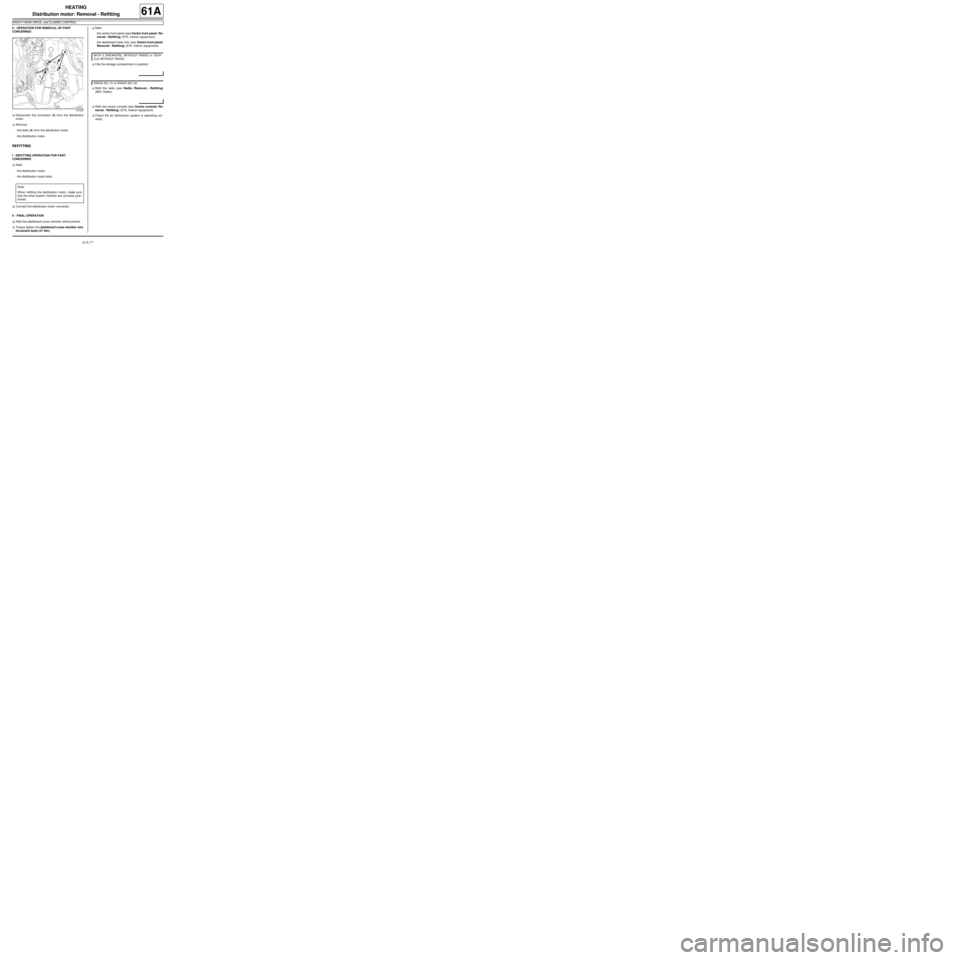
61A-77
HEATING
Distribution motor: Removal - Refitting
RIGHT-HAND DRIVE, and CLIMATE CONTROL
61A
II - OPERATION FOR REMOVAL OF PART
CONCERNED
aDisconnect the connector (3) from the distribution
motor.
aRemove:
-the bolts (4) from the distribution motor,
-the distribution motor.
REFITTING
I - REFITTING OPERATION FOR PART
CONCERNED
aRefit:
-the distribution motor,
-the distribution motor bolts.
aConnect the distribution motor connector.
II - FINAL OPERATION
aRefit the dashboard cross member reinforcement.
aTorque tighten the dashboard cross member rein-
forcement bolts (21 Nm).aRefit:
-the centre front panel (see Centre front panel: Re-
moval - Refitting) (57A, Interior equipment),
-the dashboard lower trim (see Centre front panel:
Removal - Refitting) (57A, Interior equipment).
aClip the storage compartment in position.
aRefit the radio (see Radio: Removal - Refitting)
(86A, Radio).
aRefit the centre console (see Centre console: Re-
moval - Refitting) (57A, Interior equipment).
aCheck the air distribution system is operating cor-
rectly.
141232
Note:
When refitting the distribution motor, make sure
that the drive system notches are correctly posi-
tioned.
WITH 2 SPEAKERS, WITHOUT RADIO or VEHI-
CLE WITHOUT RADIO
RADIO NO. 01 or RADIO NO. 03
Page 81 of 122
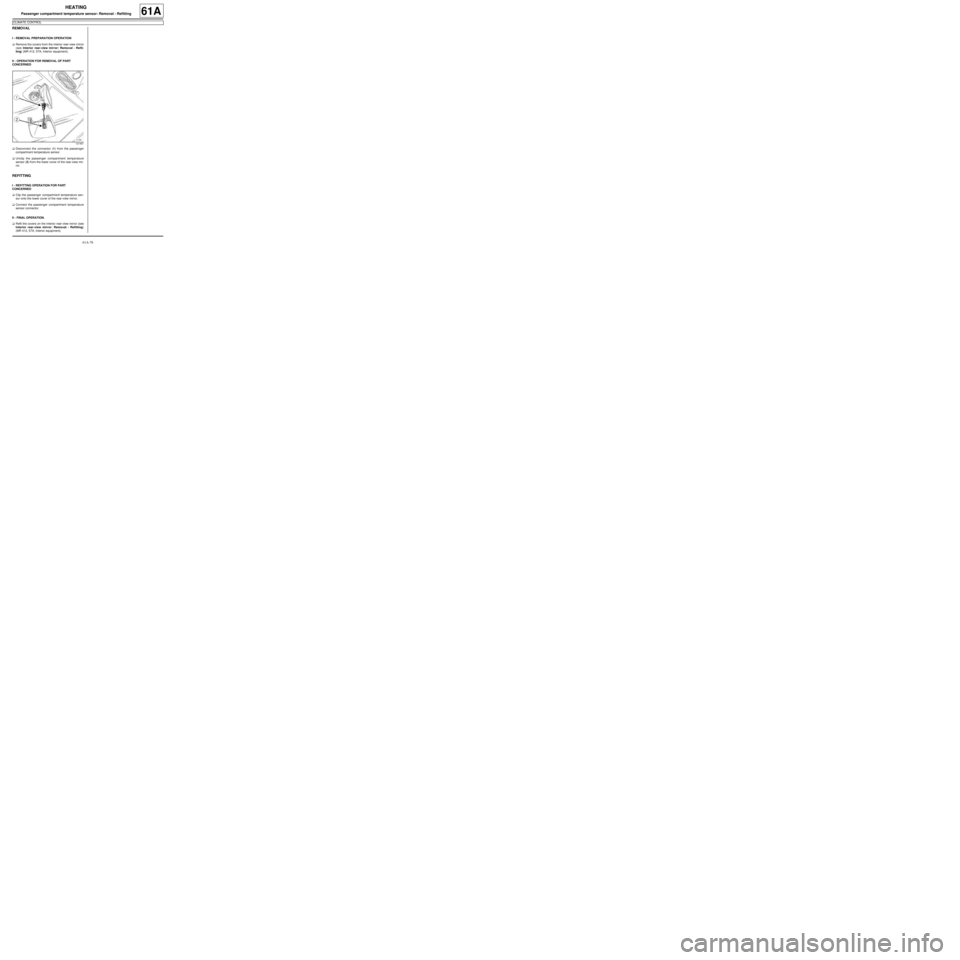
61A-78
HEATING
Passenger compartment temperature sensor: Removal - Refitting
CLIMATE CONTROL
61A
REMOVAL
I - REMOVAL PREPARATION OPERATION
aRemove the covers from the interior rear-view mirror
(see Interior rear-view mirror: Removal - Refit-
ting) (MR 412, 57A, Interior equipment).
II - OPERATION FOR REMOVAL OF PART
CONCERNED
aDisconnect the connector (1) from the passenger
compartment temperature sensor.
aUnclip the passenger compartment temperature
sensor (2) from the lower cover of the rear-view mir-
ror.
REFITTING
I - REFITTING OPERATION FOR PART
CONCERNED
aClip the passenger compartment temperature sen-
sor onto the lower cover of the rear-view mirror.
aConnect the passenger compartment temperature
sensor connector.
II - FINAL OPERATION.
aRefit the covers on the interior rear-view mirror (see
Interior rear-view mirror: Removal - Refitting)
(MR 412, 57A, Interior equipment).
121467
Page 82 of 122
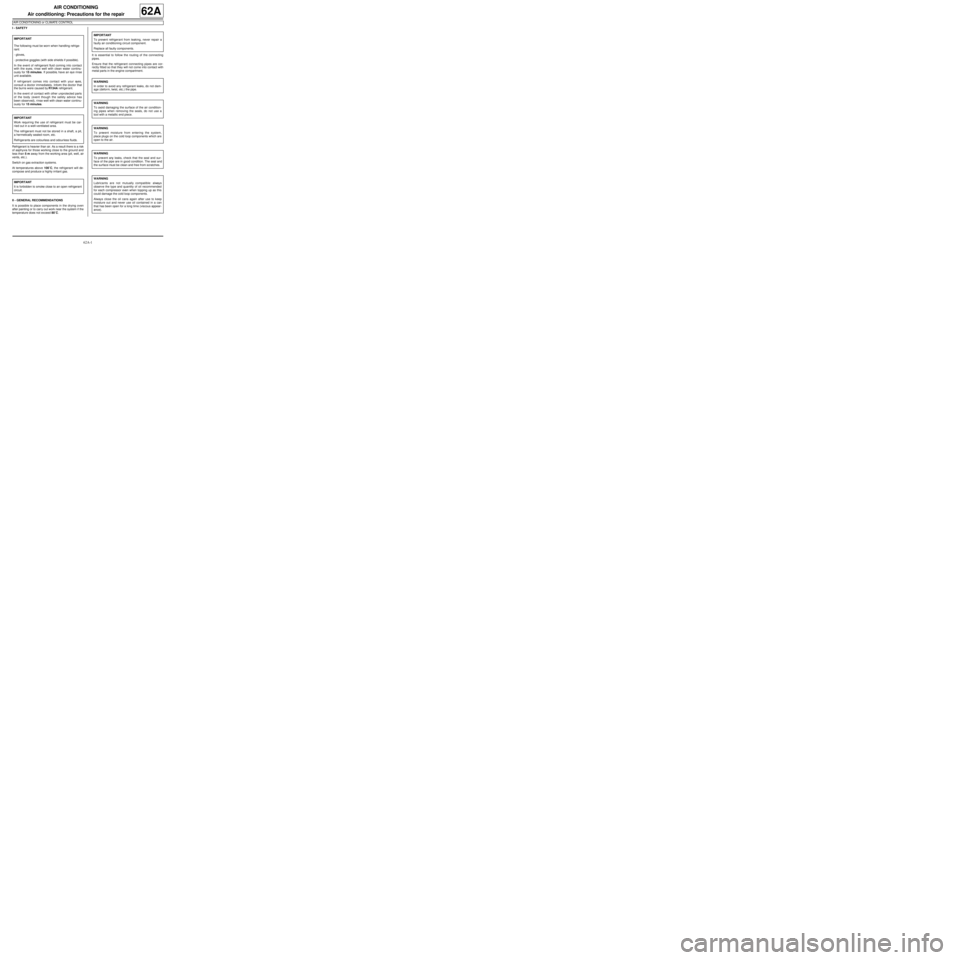
62A-1
AIR CONDITIONING
Air conditioning: Precautions for the repair
AIR CONDITIONING or CLIMATE CONTROL
62A
I - SAFETY
Refrigerant is heavier than air. As a result there is a risk
of asphyxia for those working close to the ground and
less than 5 m away from the working area (pit, well, air
vents, etc.).
Switch on gas extraction systems.
At temperatures above 100˚C, the refrigerant will de-
compose and produce a highly irritant gas.
II - GENERAL RECOMMENDATIONS
It is possible to place components in the drying oven
after painting or to carry out work near the system if the
temperature does not exceed 80˚C.It is essential to follow the routing of the connecting
pipes.
Ensure that the refrigerant connecting pipes are cor-
rectly fitted so that they will not come into contact with
metal parts in the engine compartment. IMPORTANT
The following must be worn when handling refrige-
rant:
-gloves,
-protective goggles (with side shields if possible).
In the event of refrigerant fluid coming into contact
with the eyes, rinse well with clean water continu-
ously for 15 minutes. If possible, have an eye rinse
unit available.
If refr igerant comes into contact with your eyes,
consult a doctor immediately. Inform the doctor that
the burns were caused by R134A refrigerant.
In the event of contact with other unprotected parts
of the body (event though the safety advice has
been observed), r inse well with clean water continu-
ously for 15 minutes.
IMPORTANT
Work requiring the use of refrigerant must be car-
ried out in a well-ventilated area.
The refrigerant must not be stored in a shaft, a pit,
a hermetically sealed room, etc.
Refrigerants are colourless and odourless fluids.
IMPORTANT
It is forbidden to smoke close to an open refrigerant
circuit.
IMPORTANT
To prevent refrigerant from leaking, never repair a
faulty air conditioning circuit component.
Replace all faulty components.
WARNING
In order to avoid any refrigerant leaks, do not dam-
age (deform, twist, etc.) the pipe.
WARNING
To avoid damaging the surface of the air condition-
ing pipes when removing the seals, do not use a
tool with a metallic end piece.
WARNING
To prevent moisture from entering the system,
place plugs on the cold loop components which are
open to the air.
WARNING
To prevent any leaks, check that the seal and sur-
face of the pipe are in good condition. The seal and
the surface must be clean and free from scratches.
WARNING
Lubricants are not mutually compatible: always
observe the type and quantity of oil recommended
for each compressor even when topping up as this
could damage the cold loop components.
Always close the oil cans again after use to keep
moisture out and never use oil contained in a can
that has been open for a long time (viscous appear-
ance).
Page 83 of 122
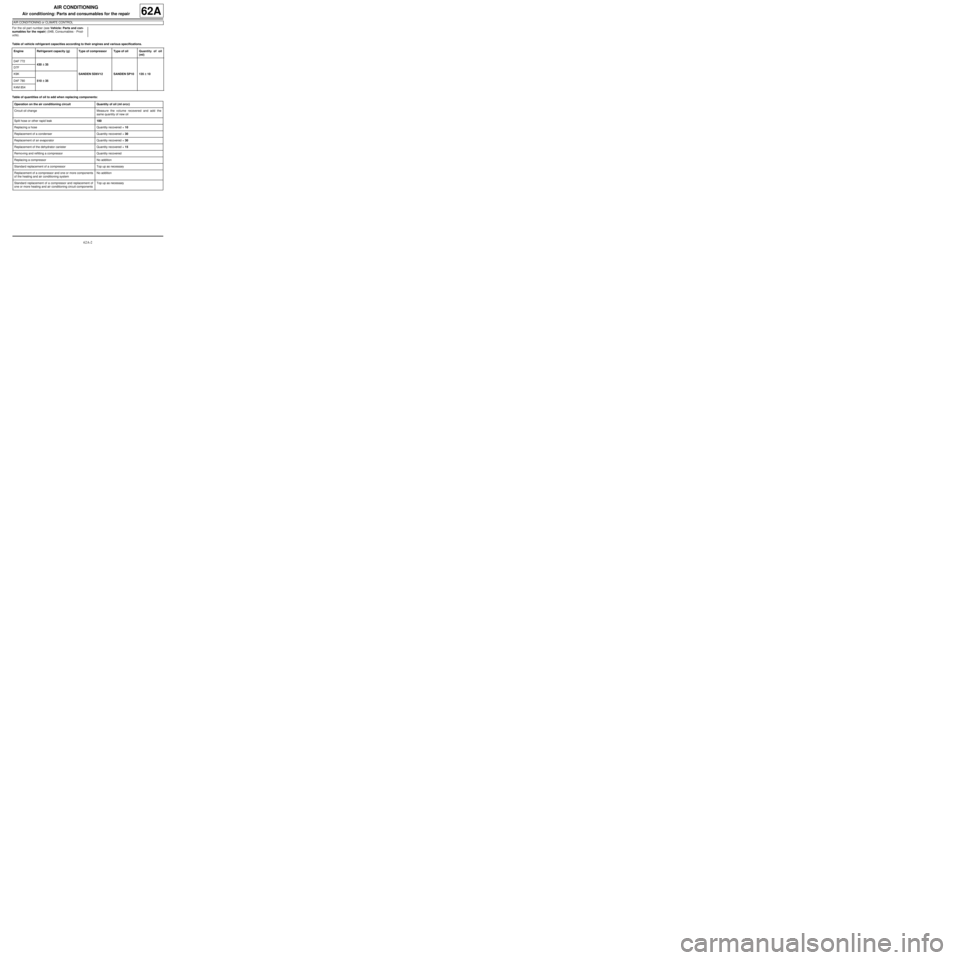
62A-2
AIR CONDITIONING
Air conditioning: Parts and consumables for the repair
AIR CONDITIONING or CLIMATE CONTROL
62A
For the oil part number (see Vehicle: Parts and con-
sumables for the repair) (04B, Consumables - Prod-
ucts).
Table of vehicle refrigerant capacities according to their engines and various specifications.
Table of quantities of oil to add when replacing components:Engine Refrigerant capacity (g) Type of compressor Type of oilQuantity of oil
(ml)
D4F 772
430 ±± ± ±
35
SANDEN SD6V12 SANDEN SP10 135 ±± ± ±
10 D7F
K9K
510 ±± ± ±
35 D4F 780
K4M 854
Operation on the air conditioning circuit Quantity of oil (ml orcc)
Circuit oil changeMeasure the volume recovered and add the
same quantity of new oil
Split hose or other rapid leak100
Replacing a hose Quantity recovered + 10
Replacement of a condenser Quantity recovered + 30
Replacement of an evaporator Quantity recovered + 30
Replacement of the dehydrator canister Quantity recovered + 15
Removing and refitting a compressor Quantity recovered
Replacing a compressor No addition
Standard replacement of a compressor Top up as necessary
Replacement of a compressor and one or more components
of the heating and air conditioning systemNo addition
Standard replacement of a compressor and replacement of
one or more heating and air conditioning circuit componentsTop up as necessary
Page 84 of 122
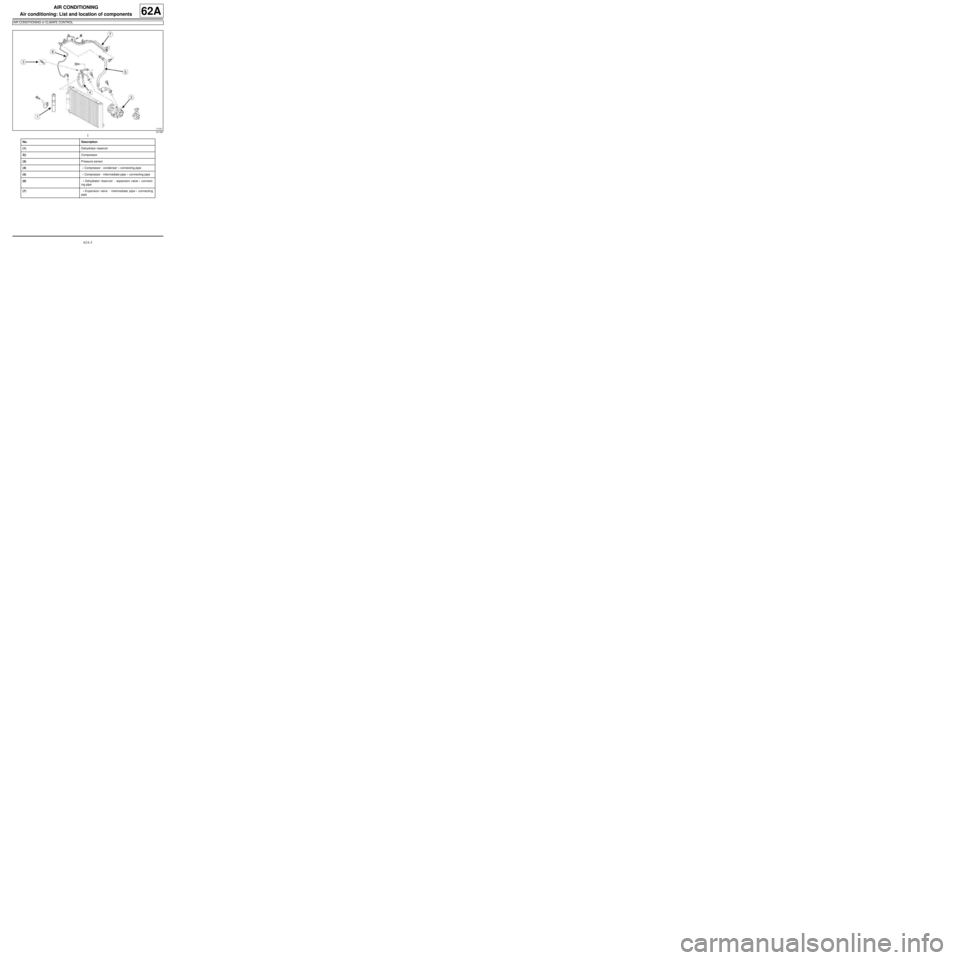
62A-3
AIR CONDITIONING
Air conditioning: List and location of components
AIR CONDITIONING or CLIMATE CONTROL
62A
121397
No. Description
(1)Dehydrator reservoir
2()Compressor
(3)Pressure sensor
(4) « Compressor - condenser » connecting pipe
(5) « Compressor - intermediate pipe » connecting pipe
(6) « Dehydrator reservoir - expansion valve » connect-
ing pipe
(7) « Expansion valve - intermediate pipe » connecting
pipe
Page 85 of 122
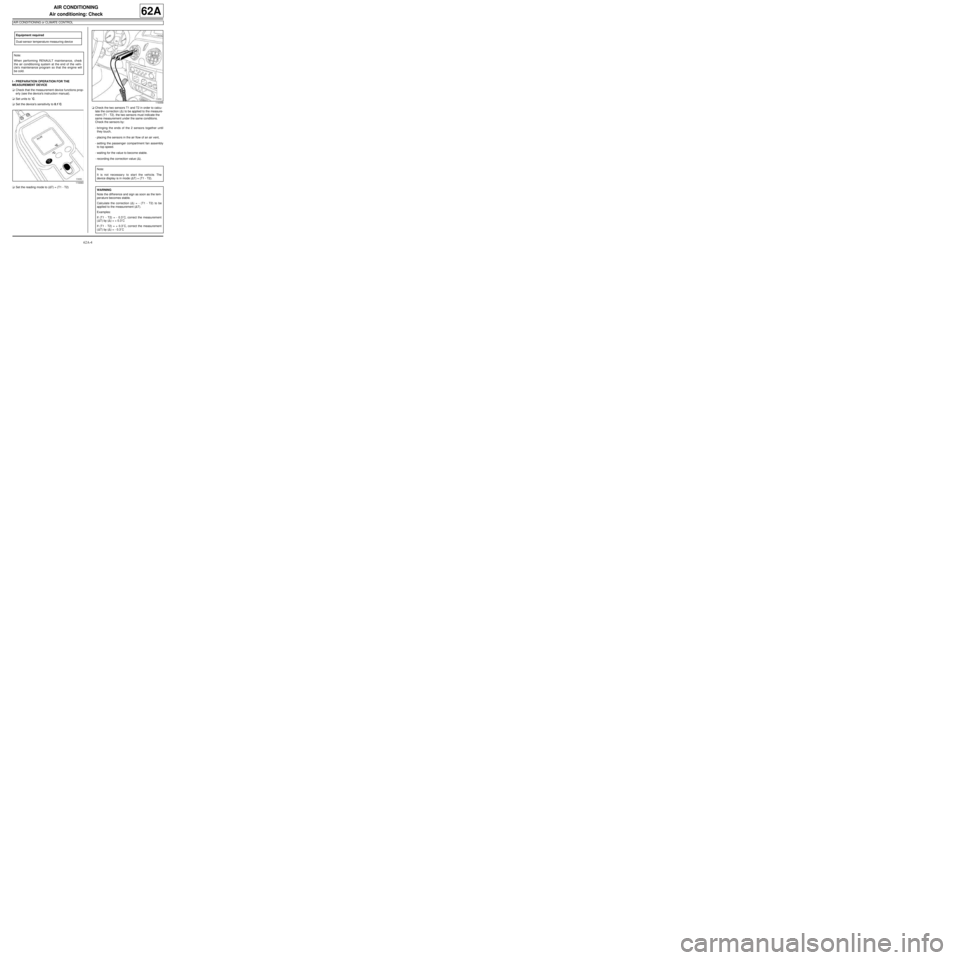
62A-4
AIR CONDITIONING
Air conditioning: Check
AIR CONDITIONING or CLIMATE CONTROL
62A
I - PREPARATION OPERATION FOR THE
MEASUREMENT DEVICE
aCheck that the measurement device functions prop-
erly (see the device's instruction manual).
aSet units to ˚C.
aSet the device's sensitivity to 0.1˚C.
aSet the reading mode to (∆T) = (T1 - T2)aCheck the two sensors T1 and T2 in order to calcu-
late the correction (∆) to be applied to the measure-
ment (T1 - T2). the two sensors must indicate the
same measurement under the same conditions.
Check the sensors by:
-bringing the ends of the 2 sensors together until
they touch,
-placing the sensors in the air flow of an air vent,
-setting the passenger compartment fan assembly
to top speed.
-waiting for the value to become stable.
-recording the correction value (∆). Equipment required
Dual-sensor temperature measuring device
Note:
When performing RENAULT maintenance, check
the air conditioning system at the end of the vehi-
cle's maintenance program so that the engine will
be cold.
119360
119358
Note:
It is not necessary to start the vehicle. The
device display is in mode (∆T) = (T1 - T2).
WARNING
Note the diff erence and sign as soon as the tem-
per ature becomes stable.
Calculate the correction (∆) = - (T1 - T2) to be
applied to the measurement (∆T).
Examples:
If (T1 - T2) = - 0.3˚C, correct the measurement
(∆T) by (∆) = + 0.3˚C
If (T1 - T2) = + 0.3˚C, correct the measurement
(∆T) by (∆) = - 0.3˚C
Page 86 of 122
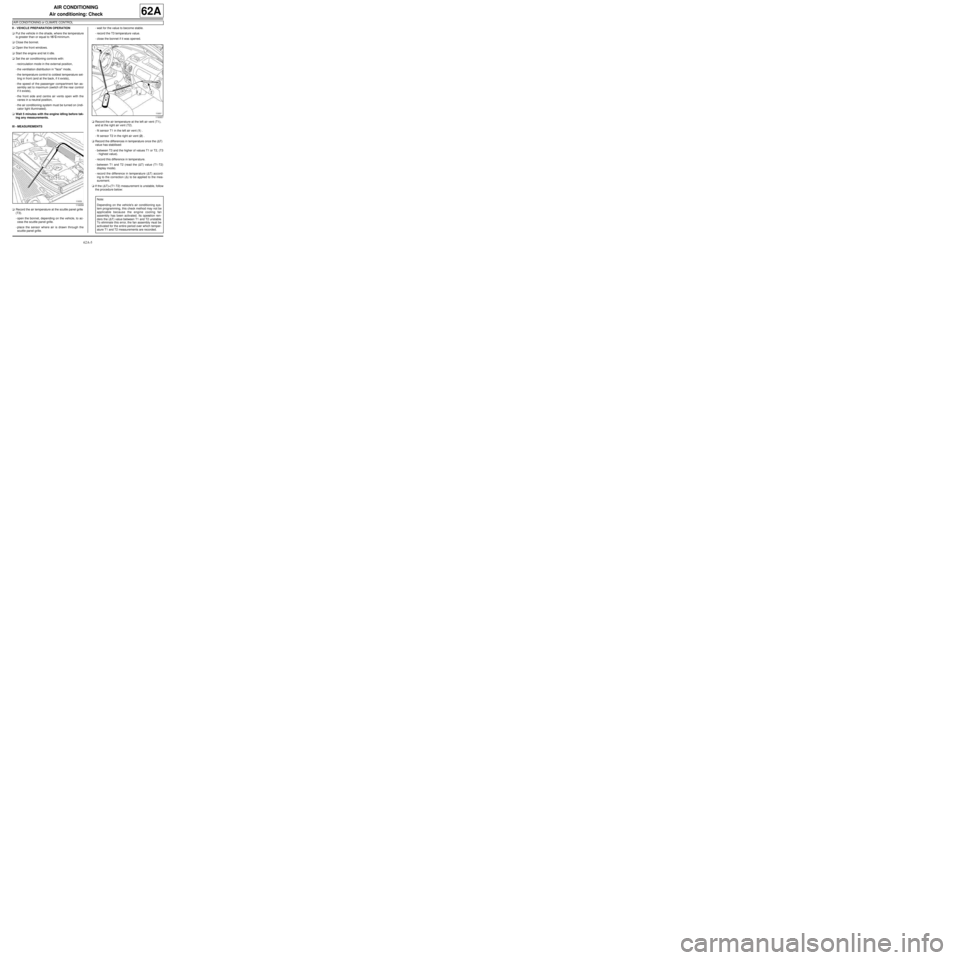
62A-5
AIR CONDITIONING
Air conditioning: Check
AIR CONDITIONING or CLIMATE CONTROL
62A
II - VEHICLE PREPARATION OPERATION
aPut the vehicle in the shade, where the temperature
is greater than or equal to 15˚C minimum.
aClose the bonnet.
aOpen the front windows.
aStart the engine and let it idle.
aSet the air conditioning controls with:
-recirculation mode in the external position,
-the ventilation distribution in "face" mode,
-the temperature control to coldest temperature set-
ting in front (and at the back, if it exists),
-the speed of the passenger compartment fan as-
sembly set to maximum (switch off the rear control
if it exists),
-the front side and centre air vents open with the
vanes in a neutral position,
-the air conditioning system must be turned on (indi-
cator light illuminated).
aWait 5 minutes with the engine idling before tak-
ing any measurements.
III - MEASUREMENTS
aRecord the air temperature at the scuttle panel grille
(T3).
-open the bonnet, depending on the vehicle, to ac-
cess the scuttle panel grille.
-place the sensor where air is drawn through the
scuttle panel grille.-wait for the value to become stable.
-record the T3 temperature value.
-close the bonnet if it was opened.
aRecord the air temperature at the left air vent (T1),
and at the right air vent (T2).
-fit sensor T1 in the left air vent (1) .
-fit sensor T2 in the right air vent (2) .
aRecord the differences in temperature once the (∆T)
value has stabilised:
-between T3 and the higher of values T1 or T2, (T3
- highest value).
-record this difference in temperature.
-between T1 and T2 (read the (∆T) value (T1-T2)
display mode).
-record the difference in temperature (∆T) accord-
ing to the correction (∆) to be applied to the mea-
surement.
aIf the (∆T)=(T1-T2) measurement is unstable, follow
the procedure below:
119359
119357
Note:
Depending on the vehicle's air conditioning sys-
tem programming, this check method may not be
applicable because the engine cooling fan
assembly has been activated. Its operation ren-
ders the (∆Τ) value between T1 and T2 unstable.
To eliminate this error, the fan assembly must be
activated for the entire period over which temper-
ature T1 and T2 measurements are recorded.